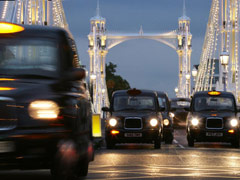


Using proper etiquette is very important in London. Our cool, avant-garde capital has hedonistic nightclubs and cutting-edge art happenings galore, but dare to not have your change ready when topping up your Oyster and you could be in for a terrifyingly frosty stare. This guide addresses the basics to life in London, from where to live to why you should always hold up your little finger when drinking tea.
Area Codes
There is a divide between north and south London as fierce as the division between the chirpy but grim, working-class north of England and the poncey south. Similarly, those saaf of the Thames regard their northern peers as useless twits, while the lack of a tube in south London means that to many it is as impenetrable as the Amazonian jungle.
Londoners aged 18 to 35 and working in the media industries live exclusively in East London. In fact, such is their devotion to the East End that each year, much like migratory birds, they travel further east, seeking to take over new untouched territory before filling it with coffee shops and crêperies. With Dalston, Whitechapel, Stoke Newington and parts of Clapton already conquered, it is predicted for the flock to arrive in Forest Gate next. It’s also worth noting that 80% of the residents of Dalston are originally from Buckinghamshire.
Personal Space
British people do not like touching in public, and are generally extremely concerned with matters like personal space. The average Londoner spends at least 40% of their time worrying about an invasion of their personal area by an intruder. There is a solution to the problem however: beer. Several pints of these (often taken on a Thursday, Friday and/or Saturday night) will result in a deep relaxation and the urge to protect ones space decreases. In fact, so effective is this technique that some Londoners find themselves openly inviting others to get close to them in a variety of ways. This can sometimes be taken to the extreme, perhaps best typified by the attempts to pole dance in the stables at Proud Camden.
It is perfectly normal for a woman to sit in a pub or restaurant on her own. She may get stared at by frisky lads, and poor attempts at chat-up lines may be made, but this is all standard behaviour.
Never take photographs in busy thoroughfares, never stop people to take your picture, and for god’s sake, don’t take pictures of a gig/DJ set/restaurant meal. Your friends should still believe you were there without the photographic evidence on Facebook, and if they don’t then you might want to consider why no one trusts you.
\n\nTable manners
Have you ever wondered why it is traditional to hold up one’s little finger whilst drinking tea? The reason is that once upon a time teacups had no handles, and the easiest way to balance the cup without spilling was to grasp it with the thumb and index fingers, holding the pinkie up for balance. Have you ever spilt boiling hot tea over yourself? That’s because you weren’t holding your pinkie up.
The World of Work
In an office environment, humour will go a long way. Mildly self-deprecating comments with a hint of sarcasm work best; avoid toilet humour and making jokes at other people’s expense unless you’re in a managerial position.
Events like cricket and the Henley Regatta are held in very high esteem indeed, so should a work colleague invite you to attend, the invitation must be accepted. To make a good impression one must dress appropriately; a blazer, shirt and tie should be worn by the men, tasteful dresses should be worn by the ladies. After the event, it is custom for the men to repair to the nearest pub and proceed to get bladdered. Lairyness is the norm, sexist remarks optional.
\n\nGetting Around
In Britain cars drive on the left, unlike in most other countries in the world, where people drive on the right. In London the same rules apply, along with a maximum speed of 2 miles per hour within inner London boroughs throughout the day. Don’t bother trying to go over this limit as you will only be speeding up to the traffic lights.
If you take longer than 45 seconds to purchase a ticket/top up your Oyster at a London Underground ticket machine you can expect to be greeted with a barrage of cold air (and in some instances, swearing) when you walk past the lengthy line of waiting customers that has formed behind you. When it comes to getting around in London, speed is of the essence, so the faster you swipe your card, get through the barriers and move to the middle of the carriage the better.
Brits have a reputation for being fond of queuing, but this doesn’t apply on the tube platforms. Between the hours of 7.30 am and 9.30 am, and 4.30 pm and 7 pm, it’s every man to himself. As the roar of the train alerts waiting passengers to its arrival, they begin to edge closer to the yellow line. People stand in front of the doors, nervously waiting for them to open, blocking the way of anyone exiting the train. If you were first in line, that privilege will disappear as soon as the doors open and everyone scrambles forwards as if it was the last tube ever to exist. Note that usual tools of etiquette, i.e. using “excuse me” and “pardon” will not work here.


